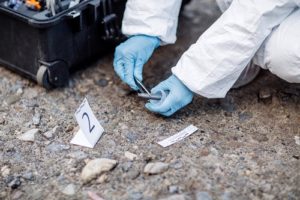When you submit a concrete sample for petrographic examination, how big a sample do you need? That is, what’s the appropriate concrete sample size? We’ve discussed in previous posts how to take good concrete cores and how to get a representative sample.
What are you looking for?
ASTM C856 states that you need a core with a diameter at least twice, and preferably three times, the maximum size of the aggregate. But it isn’t always possible to get a sample that large. It’s one thing if you’ve got an extra cylinder of the concrete in question from the job site. It’s fairly easy to get a technician to cast a couple of extra cylinders “just in case.” If you’ve done that you’ve got the ideal petrographic specimen–assuming you want to know about the concrete as delivered to the site.

But if you’re looking at the condition of the concrete as placed–or after it’s started to deteriorate–you’ll need to take cores. This is where it can get tricky. If you’re looking at a driveway or an unreinforced pavement, you’re in luck. Just get the largest-diameter bit you can and drill through the full thickness of the concrete.
However, in structural concrete you’ll need to avoid drilling into prestressing tendons. You’ll most likely want to avoid reinforcing bars and in-floor heating cable as well. If you’ve got a heavily reinforced structure you’ll end up with a smaller concrete sample size. What do you do then?
Ask us!
At this point it’s probably best to consult with us to see what’s doable and what matters most. If you’re concerned about deterioration of the concrete or chloride ions migrating toward the reinforcing bars, the near-surface concrete matters most. It may be good enough to sample the concrete above the rebar mat in that case. Keep in mind, though, that it’s a lot easier to break off a core if it’s longer than its diameter–preferably twice as long.
Because the petrographer is examining the spatial relationships among the concrete components, it’s important to have an intact sample. A handful of concrete fragments–or a detached surface with the core beneath it–will not do. And documentation of where the sample came from is very important; it provides the context for the sample.
